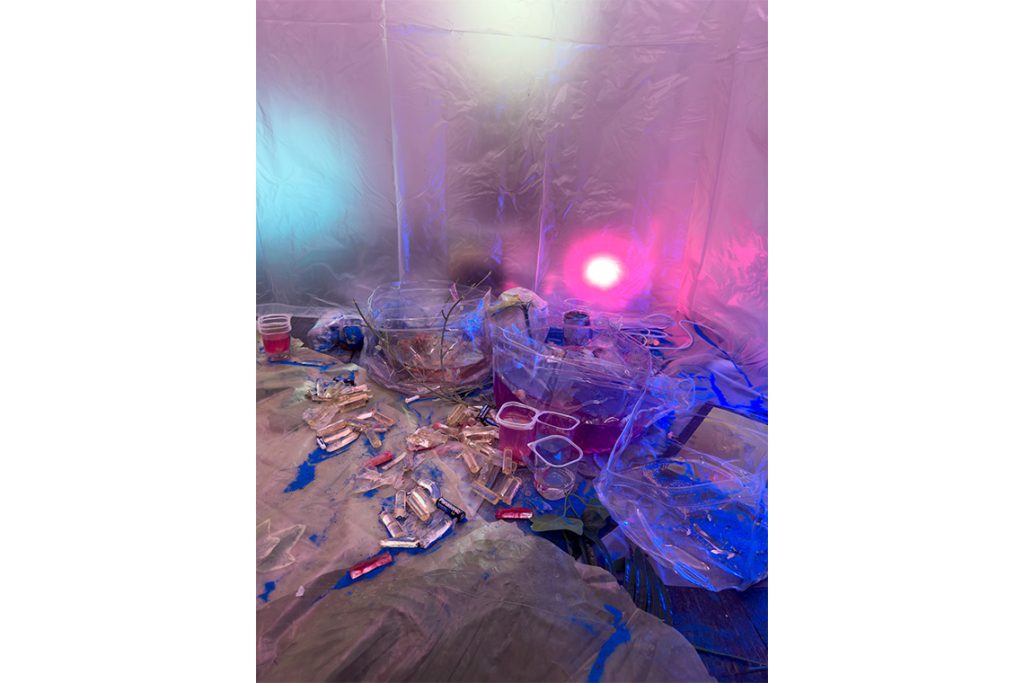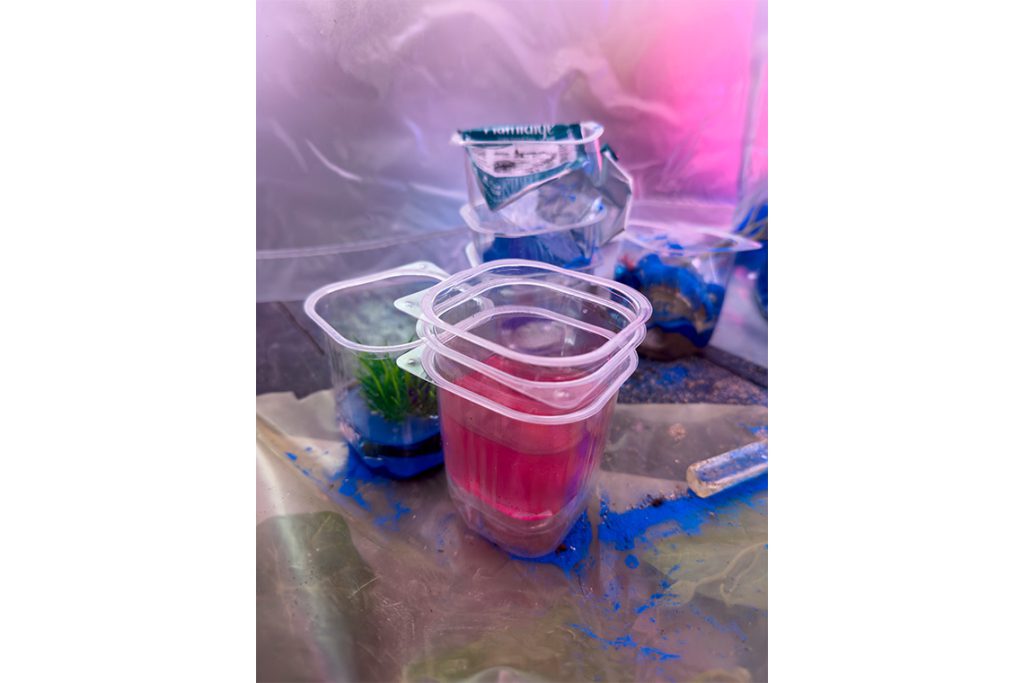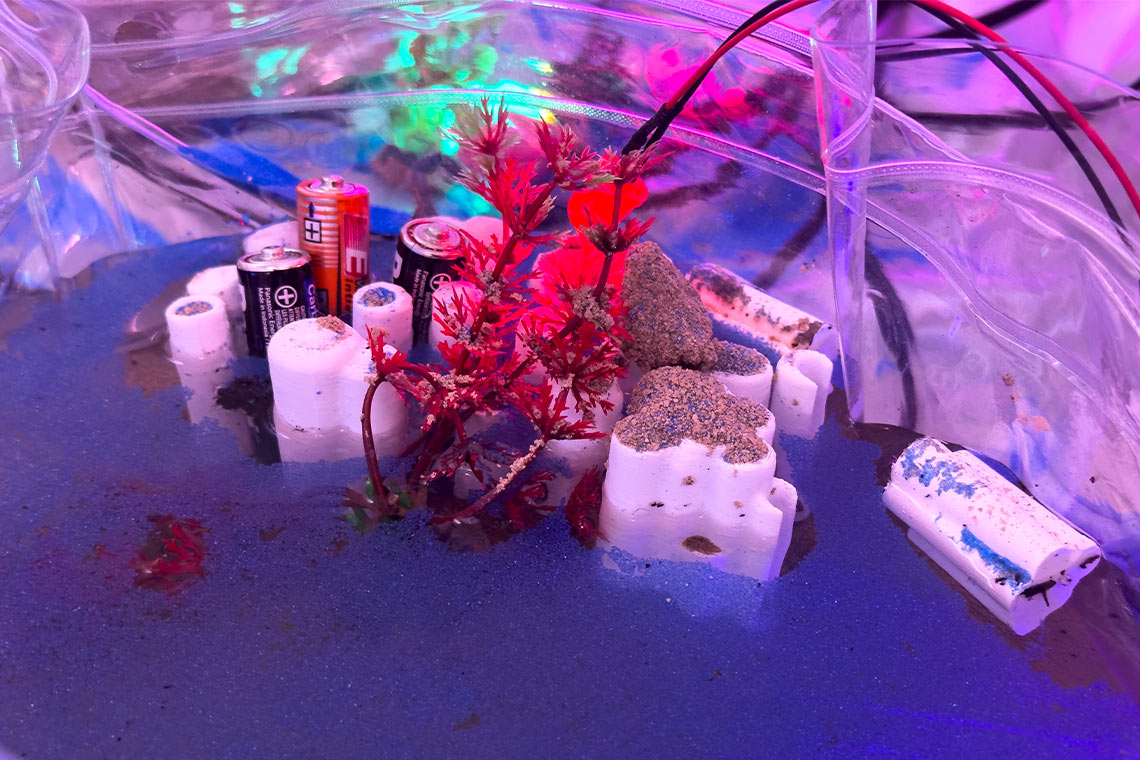Kerem Ozan Bayraktar’s site-specific installation at Diana New York toys with the apocalypse.
It’s an uncertain winter afternoon, the brisk air caught between New York’s traditional grey January and the city’s latest incarnation as a place where winter rarely arrives. Downtown, the blocks are tense interzones, between Asian-American communities bracing for ICE, Dimes Square yuppie scum shitposting, and artists trying to show their work to audiences often more interested in showing they’ve seen it. Halfway down one of these blocks is the old Fierman contemporary art gallery, which is now the gallery Diana, New York, a partnership between Nadine Knotzer and Kourosh Nouri of Dubai’s Carbon 12, Sarah Macaulay of Macaulay and Co. Fine Art in Vancouver, and David Fierman himself. The space is bright, narrow, vaulted. On this particular afternoon, plastic sheets cover the walls and floors, as if a show has not yet happened, or perhaps has already ended. A side wall offers a series of photographs: coral mist, flooded muck, plastic jugs afloat like oil tankers, bits of branches and flotsam and debris. Whatever this was, you’re missing it.

Deeper in, a curtain of plastic sheeting joins a carpet of plastic sheeting, trapping vines of what must be artificial life. Nothing organic could survive this. Or could it? Spirits on the Ground is Kerem Ozan Bayraktar’s first solo show in the United States, curated by Ulya Soley and presented by Sanatorium from Istanbul, where Bayraktar is based. It follows his Ghost Gardens installation at the Tokyo Biennale 2023, in which he and Buşra Tunç filled a vacant shopping mall warehouse with digital tablets, concrete and tarpaulins, and restages a show by the same name that he installed in 2020 at SAHA Studio in Istanbul. Which is all to say, this New York site is a link between territories, or perhaps a disregarding of them. The show itself also trashes borders, playing with the lines between life and death.
Deeper in, a curtain of plastic sheeting joins a carpet of plastic sheeting, trapping vines of what must be artificial life. Nothing organic could survive this. Or could it? Spirits on the Ground is Kerem Ozan Bayraktar’s first solo show in the United States, curated by Ulya Soley and presented by Sanatorium from Istanbul, where Bayraktar is based. It follows his Ghost Gardens installation at the Tokyo Biennale 2023, in which he and Buşra Tunç filled a vacant shopping mall warehouse with digital tablets, concrete and tarpaulins, and restages a show by the same name that he installed in 2020 at SAHA Studio in Istanbul. Which is all to say, this New York site is a link between territories, or perhaps a disregarding of them. The show itself also trashes borders, playing with the lines between life and death.

Traversing the switchback path through the gallery, little patches of soil drift across the groundcover of plastic-covered plastic plants. Landscapes emerge: foothills of synthetic buckets and bags anchored in murky depths of water supporting ecosystems of what look variously to be botanicals on their deathbeds and petroleum-based versions whose material affords them a kind of eternal life.
Also in the bucket? Riffs on skylines emerging from the sludge, their spires and towers formed from the shells of batteries. Those power sources also wash up among the tributaries swirled around the buckets and bags, logos still bright, as if new feeders for unseen bays nearby. Some are rechargeable, the closest thing to reincarnation we know. All can be thought of as cells, in which the lifeforce is trapped until it may be released, and which alternatively can be linked to the creation of something larger – the fuel for a city, or that for a child’s imagination. LED lights and cables float across Bayraktar’s constructions, bringing screens to life that play scenes of glitchy, kitschy creatures. One, in which a pile of toy birds peck inside a plastic bag, plays on a phone. Perhaps a foot away, a larger screen displays what might be polka-dot toy horses, their topsy-turvy limbs galloping nowhere. In the back, a tv set plonked on the floor becomes an electrical pool for wandering neon-bright fish as it plays footage of unclear origin – a video of an installation, a document of what happened in the photos at the entrance, a rising tide of AI slop?

Little emptied cups of packaged water also litter the space, some retaining their foil top complete with branding from the Turkish manufacturer Hamidiye Su. A company “making” water is a miracle of Capitalism. Spirits on the Ground furthers the corporate transubstantiation from element to product to make it natural once again – if, in fact, the little green sprouts are plants and not petroleum, and if, furthermore, we’re to think of moulded and hardened oil as unnatural. Maybe thinking of the manmade as artificial only serves the lie that humans aren’t a part of nature. Bayraktar toys with these ideas, asking us to get down on a ground protected by plastic so nothing stains, nothing is forever, and play. He reminds us that a dead battery isn’t really dead: its shell can find life as something else. Its contents – all that lead, mercury, cadmium or lithium – retain lethality as it leaks and poisons unprotected ground and water. (Better put down a tarp.)
This generative energy lives in the memories of playing with toys as a kid, the images we remember and try to forget on our televisions, the intimate interregnum that swells wide with each check of our phones. Spirits on the Ground is a duet of the plastic and the plasticity of meaning, a trash-heap pretty in the pink of James Bidgood’s bedroom fantasias, the hue-coded millennial and part of bisexual lighting, the colour of Sigmar Polke’s uranium portraits, the warming chill-out that La Monte Young and Marian Zazeela imbue into their Dream House. Back out on the sidewalk, the golden hour is rosy too. Not optimism, but polluted. That’s pretty, too.



